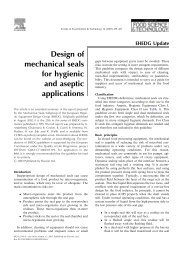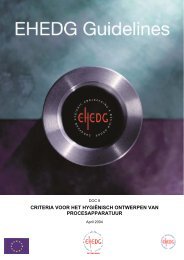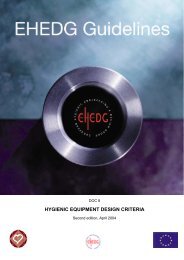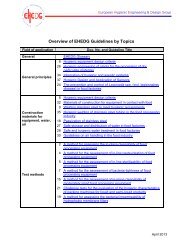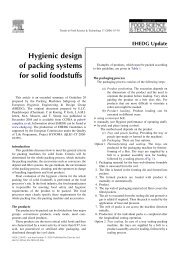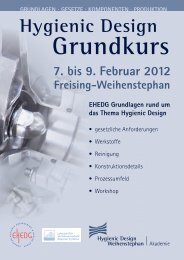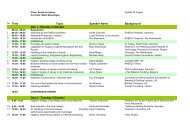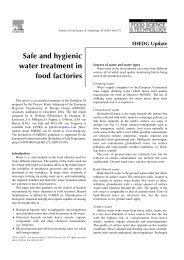Yearbook 2013/2014 - ehedg
Yearbook 2013/2014 - ehedg
Yearbook 2013/2014 - ehedg
You also want an ePaper? Increase the reach of your titles
YUMPU automatically turns print PDFs into web optimized ePapers that Google loves.
118 Hygienic automation technology in food production<br />
The three production zones<br />
The European standard EN 1672-2, Food processing<br />
machinery - Basic concepts, defines three production zones:<br />
• The food zone<br />
This zone encompasses all system parts and<br />
components that are mounted directly in the food<br />
flow and come into contact with foodstuffs. Food may<br />
become contaminated and end up back in the product<br />
flow. System parts and components that come into<br />
contact with foodstuffs must be easy to clean and<br />
disinfect. They should be corrosion-resistant, non-toxic<br />
and non-absorbent (Figure 2). A smooth, continuous<br />
or sealed surface reduces the chance of food getting<br />
caught and leaving residue that is difficult to remove,<br />
making it a contamination risk. In addition, only special<br />
food-compatible lubricants may be used.<br />
• The splash zone<br />
In the splash zone, machine parts and components<br />
come into direct contact with foodstuffs, but the<br />
food does not end up back in the product flow.<br />
Nevertheless, these parts must be designed and built<br />
according to the same criteria as those in the food<br />
zone.<br />
• The non-food zone<br />
In this zone, the machine components do not come<br />
into contact with the product. However, the system<br />
parts used in this zone should be manufactured from<br />
corrosion-resistant materials and be easy to clean and<br />
disinfect, as sources of infection can develop over time.<br />
Selecting the material<br />
In order to protect food, the machine components must<br />
not deposit any substances during the production process<br />
that are harmful to health or that impair the taste or aroma,<br />
through either direct or indirect contact with the food. To<br />
make certain that the work carried out during the cleaning<br />
phase is safe, the materials used for the machine parts<br />
must not react with the cleaning agents or the antimicrobial<br />
chemicals (disinfectants). They must be corrosion-resistant<br />
and mechanically stable to prevent the surface from being<br />
adversely affected.<br />
Figure 3: Quick and easy cleaning can be accomplished with large<br />
radii, such as those of the standard cylinder Clean Design DSBF.<br />
Common materials<br />
• Austenitic stainless steel<br />
High-alloy stainless steel is usually the logical choice<br />
of material for the construction of a production<br />
system in the food industry. Typical materials include<br />
AISI-304, AISI-316 and AISI-316L (DIN material no.<br />
1.4301/1.4401/1.4404).<br />
• Aluminium<br />
Aluminium is frequently used for construction. It is<br />
affordable and easy to work with and process. Typical<br />
aluminium grades include AlMg2Mn0.8, AlMgSi1 and<br />
AlMgSi0.5. Aluminium components can be rendered<br />
resistant to cleaning agents through the application of<br />
an additional coating or anodised oxide layer.<br />
• Plastics<br />
Plastic components permitted to come into direct<br />
contact with food must comply with Regulation<br />
1935/2004/EC and the Plastics Directive 10/2011<br />
(which replaces Regulation 2002/72/EU) or the<br />
approvals of the FDA (CFR 21, Sections 170-199).<br />
In addition to resistance to strain, ease of cleaning<br />
also is an important factor in the selection of suitable<br />
plastic materials. They must not give off or absorb any<br />
hazardous substances.<br />
• Lubricants<br />
Lubricating greases and oils must comply with FDA<br />
regulations (especially Section 21 CFR 178.3570) or<br />
ISO 21469. For parts that will unavoidably come into<br />
sporadic contact with foods, approved lubricants as per<br />
NSF-H1 must be used.<br />
Hygienic component design<br />
The application of EN 1672-2, ISO 14159 and DOC 8+13<br />
of the EHEDG forms the basis for the hygienic design of<br />
machines and components. These standards take into<br />
account the fundamental design elements that can be used<br />
in the construction of components and systems.<br />
• Surfaces<br />
A high surface finish is absolutely essential on<br />
components that come into contact with the product<br />
in order to reduce microbial contamination. This can<br />
be achieved by using a mean peak-to-valley height of<br />
0.4 to 0.8 µm within the food zone. Components with a<br />
peak-to-valley height of ≤ 3.2 µm are often used in the<br />
splash zone.<br />
• Connecting pieces, threads<br />
Connecting components, such as screws, bolts,<br />
rivets and so on, may cause hygiene problems. Open<br />
threads are difficult to clean and provide the perfect<br />
breeding ground for bacteria. Any threads that cannot<br />
be avoided should therefore be closed off with suitable<br />
covers and seals.<br />
• Inner angles, corners and radii<br />
Very small radii and corners are always a hygiene risk<br />
as they are difficult to clean. The prescribed minimum<br />
radius is 3 mm (Figure 3).



